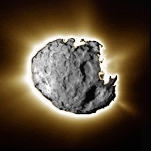Geoscientist 20.04 April 2010 (Online Special)
Wild surmise - the Stardust Mission

Volume 44 (10) of
Meteoritics and Planetary Science (all 1681 pp of it) is entirely devoted to the results of the Stardust Mission to recover samples from the tail of the Jupiter family (short period) comet 81P/Wild-2. This is an esoteric subject of research, but the conclusions are encapsulated in a summary, ‘Insights from the unexpected’ by J P Bradley et al.
1
First the results: the modification of the cometary particles during capture in aerogel was an unforeseen complication but can be compensated for (the phenomenon mainly affected organic grains and sulphide particles, and caused “smelting out” of metallic iron). The cometary grains were larger than predicted, solid grains of more than a micrometer in size being abundant. Grains up to 40 micrometers across were sectioned and left carrot-shaped tracks. But the big surprise was the origin of the cometary materials recovered.
The general expectation was that comet solids were predominantly composed of pre-solar grains, both pristine amorphous interstellar grains and some that had experienced partial crystallisation within the solar nebula by solid-state annealing at temperatures near 1000K. Isotopically anomalous pre-solar circumstellar grains are rare in the samples recovered, and less than are found in primitive chondrites.
The most surprising finding was that most of the cometary solids were high temperature inner nebula materials commonly found in chondrite meteorites- forsterite, chondrule fragments, ‘CAI’ fragments (calcium-aluminium rich inclusions). These mostly did not form from annealing of sub-micron-sized interstellar grains, and were the material that formed by the same processes as meteoritic components.
There is a broad mix in the Wild-2 samples, but they are unequilibrated with respect to another: olivine grains separated by less than a micron can have different Fe contents. These solids were not modified by parent body processes after they became encased in ice. The whole story requires a transport of inner solar system materials to the outer solar system - very early, between the formation of the CAI’s and the chondrule formation a million or so years later, the transport being by some process as yet unknown. The big find of the project was the organic compound glycine, as reported in December last year
2 . The comet samples shed a completely new light on the problem of the origin of chondrules
3.
The philosophical implications of these surprising results are immense. Scientists have here been proved completely wrong in their predictions about comets and cheerfully accept this. There is a common supposition that if one takes a problem to a scientist one gets a single, correct answer. This fallacy permeates the Climate Change Controversy. Scientists, in fact, commonly disagree among themselves (this is healthy, and how science progresses). They may be completely wrong. It is quite possible that the complexities, interplays and feedbacks involved in the changes of global climate are such that it is quite impossible for science to give accurate predictions. There has been a lot of suggestion of scientists falsifying results in the media. This, which I call the ‘Gupta factor’, after the most famous recent geoscience practitioner of scientific fraud, may exist – but it is surely not the main problem.
A distinguished colleague of mine has suggested that the confusion is partly due to the way science is organised into compartments (disciplines): I myself believe that it is the utter complexity of the global processes involved that may be the problem. The Stardust case illustrates how very distinguished and well-qualified scientists can still find the totally unexpected in the results of brilliantly and soundly planned experiments.
Refs:
- Bradley, J.P. Jones. A.P. Brownlee, D.E 2009. Insight from the unexpected. Meteoritics and Planetary Science 44(10); 1403-1405.
- McCall, Joseph. Glycine in particles from the tail of Comet Wild-2. Geoscientist 19(12); 14.
- McCall, G.J.H 2005. Chondrules and calcium-aluminium rich inclusions (CAIs). In: McCall, G.J.H., Bowden, A.J., Howarth, R.J., eds. “The History of Meteoritics and Key Meteorite Collections.”. Geological Society, London, Special Publication 256; 345-361.